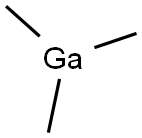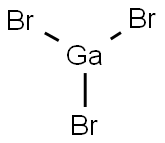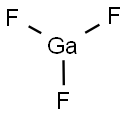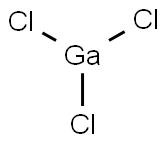Gallium
Synonym(s):GA006120;Gallium;Gallium element
- CAS NO.:7440-55-3
- Empirical Formula: Ga
- Molecular Weight: 69.72
- MDL number: MFCD00134045
- EINECS: 231-163-8
- SAFETY DATA SHEET (SDS)
- Update Date: 2024-12-18 14:07:02

What is Gallium?
Description
Gallium is the 32nd most abundant element and constitutes 0.0005% of the Earth’s crust. It is found most commonly in association with zinc, germanium, and aluminum and is found primarily in the mineral germanite. Gallium(III) is the primary oxidation state for gallium compounds; its chemistry resembles that of aluminum(III).
Chemical properties
Gallium is a lustrous, silvery liquid, metal, or gray solid.It is a silvery liquid at 29.75 °C (85.55 °F), which boils at 2204 °C (3999.2°F) and has the largest liquid range of any metal. Despite the liquid state, the vapor pressure of elemental gallium is negligible. Indium is a silvery-white, malleable metal that melts at 156 °C (312.8 °F) and boils at 2072 °C (3761.6°F). Oxides of both elements are amphoteric. Both gallium and indium form arsenides, halides, hydroxides, oxides, and phosphides, some of which may be degraded by acids and fire to produce highly toxic gases such as arsine and stibine. Reaction of indium oxide with water produces an insoluble indium hydroxide [In(OH)3], which limits mobilization in solution. Gallium salt solubility increases with increasing ionic strength.
Physical properties
Gallium is soft and bluish off-white when solid and silvery in color as a liquid. It is softenough to cut with knife and has an extremely low melting point. When held in the hand, itwill melt from body heat as it becomes mirror-like in color. It expands when changing backfrom a liquid to a solid. When cold, it becomes hard and brittle. Of all the metals, galliumexhibits the largest range of temperatures from its liquid phase to its solid phase, and, likewater, it expands when it freezes. Its melting point is 29.76°C, its boiling point is 2,204°C,and its density is 5.903 g/cm3,.
Isotopes
There are 33 isotopes of gallium, two of which are stable. They are Ga-69, whichmakes up 60.108% of the element’s presence in the Earth’s crust, and Ga-71, which contributes39.892% of the gallium found in the Earth’s crust. All the other 31 isotopes areradioactive with half-lives ranging from a few nanoseconds to about 15 hours.
Origin of Name
Latin word Gallia, meaning “Gaul,” an early name for France.
Occurrence
Gallium is the 34th most abundant element, but it is not widely distributed as an elementalmetal. It is usually combined with other elements, particularly zinc, iron, and aluminum ores.It is found in diaspore, sphalerite, germanite, gallite, and bauxite. Although small amounts arerecovered from burning coal used for heating or generation of electricity, it is mostly recoveredas a by-product from the production of ores of other metals. Gallium is about as abundant aslead in the Earth’s crust.
Since 1949, the Aluminum Company of America has extracted gallium metal from aluminumbauxite ore. In the past gallium had few uses. Only recently, with the development ofmicroprocessors, chips, computer, and the like, has gallium found many profitable uses.
History
Gallium was predicted and described by Mendeleev as ekaaluminum, and discovered spectroscopically by Lecoq de Boisbaudran in 1875, who in the same year obtained the free metal by electrolysis of a solution of the hydroxide in KOH, it is often found as a trace element in diaspore, sphalerite, germanite, bauxite, and coal. Some flue dusts from burning coal have been shown to contain as much as 1.5% gallium. Gallium is the only metal, except for mercury, cesium, and rubidium, which can be liquid near room temperatures; this makes possible its use in high-temperature thermometers. It has one of the longest liquid ranges of any metal and has a low vapor pressure even at high temperatures. There is a strong tendency for gallium to supercool below its freezing point. Therefore, seeding may be necessary to initiate solidification. Ultra-pure gallium has a beautiful, silvery appearance, and the solid metal exhibits a conchoidal fracture similar to glass. The metal expands 3.1% on solidifying; therefore, Gallium should not be stored in glass or metal containers, as they may break as the metal solidifies. Gallium wets glass or porcelain, and forms a brilliant mirror when it is painted on glass. It is widely used in doping semiconductors and producing solid-state devices such as transistors. High-purity gallium is attacked slowly only bymineral acids. Magnesium gallate containing divalent impurities such as Mn+2 is finding use in commercial ultraviolet activated powder phosphors. Gallium nitride has been used to produce blue light-emitting diodes such as those used in CD and DVD readers. Gallium has found application in the Gallex Detector Experiment located in the Gran Sasso Underground Laboratory in Italy. This underground facility has been built by the Italian Istituto Nazionale di Fisica Nucleare in the middle of a highway tunnel through the Abruzzese mountains, about 150 km east of Rome. In this experiment, 30.3 tons of gallium in the form of 110 tons of GaCl3-HCl solution are being used to detect solar neutrinos. The production of 71Ge from gallium is being measured. Gallium arsenide is capable of converting electricity directly into coherent light. Gallium readily alloys with most metals, and has been used as a component in low melting alloys. Its toxicity appears to be of a low order, but it should be handled with care until more data are forthcoming. Natural gallium contains two stable isotopes. Twenty-six other isotopes, one of which is an isomer, are known. The metal can be supplied in ultrapure form (99.99999+%). The cost is about $5/g (99.999%).
Characteristics
Gallium is truly an “exotic” element in that it has so many unusual characteristics. It canform monovalent and divalent as well as trivalent compounds. It is considered a “post-transitionalmetal” that is more like aluminum than the other elements in group 13. It has fewsimilar characteristics to the two elements just below it in group 13 (In and Ti).
Gallium reacts strongly with boiling water, is slightly soluble in alkali solutions, acids,and mercury, and is used as an amalgam. It has some semiconductor properties but only if“doped” with elements in group 14, such as As, P, and Sb. It is also used as a “dope” for othersemiconducting elements.
The Uses of Gallium
The compound gallium arsenide (GaAs) has the ability to convert electricity directly intolaser-light used as the laser beam in compact disc players. It is also used to make light-emittingdiodes (LEDs) for illuminated displays of electronic devices such as watches. Gallium isalso a semiconductor that when used in computer chips generates less heat than silicon chips,making it a viable option for designing supercomputers that otherwise would generate excessiveheat.
The radioisotope of gallium-67 is one of the first to be used in medicine. It has the abilityto locate and concentrate on malignant tissue, such as skin cancers, without harming normaltissue in the same area.One of the more recent uses of gallium is based on the fact that normal gallium, whenbombarded by neutrinos, is converted into the radioisotope germanium-71, which can bedetected by sensitive instruments. Neutrinos are subatomic particles that “bathe” the Earth asa product of the sun’s thermonuclear activity and, from outer space, and can easily go throughmiles of solid rock.
Gallium makes a safe substitute for mercury amalgams in dental fillings when it is combinedwith tin or silver.
Because of its high range of temperatures as a liquid (from 29.8°C to 2,403°C), it is usedin special types of high-temperature thermometers. It is also alloyed with other metals to makealloys with low temperature melting points.
Because of the unique property of some of its compounds, gallium is able to translate amechanical motion into electrical impulses. This makes it invaluable for manufacturing transistors,computer chips, semiconductors, and rectifiers.
The Uses of Gallium
The metal has no significant commercial uses. Its compounds are used as semiconductors.
The Uses of Gallium
Gallium and gallium compounds have numerous uses in
optoelectronics (e.g., LEDs), telecommunication, aerospace,
and many commercial and household items, for example,
alloys, computers, and DVDs. In addition, gallium is used in
special high-temperature thermometers, in place of mercury,
and in arc lamps.
Medically, gallium alloys are used in dental prostheses,
radioactive gallium has been used to locate bone lesions, and
nonradioactive gallium has been used as an antitumor agent.
Gallium has been used experimentally as an adjunct to cisplatinum
cancer chemotherapy. It has also been used to treat
hypercalcemia and inhibit bone resorption. Gallium maltolate
is under development as a treatment for Paget’s disease.
Definition
Metallic element of atomic number 31, group IIIA of the periodic table, aw 69.72, valences of 2, 3; two stable isotopes.
Definition
gallium: Symbol Ga. A soft silverymetallic element belonging to group13 (formerly IIIB) of the periodictable; a.n. 31; r.a.m. 69.72; r.d. 5.90(20°C); m.p. 29.78°C; b.p. 2403°C. Itoccurs in zinc blende, bauxite, andkaolin, from which it can be extractedby fractional electrolysis. Italso occurs in gallite, CuGaS2, to anextent of 1%; although bauxite onlycontains 0.01% this is the only commercialsource. The two stable isotopesare gallium–69 and gallium–71;there are eight radioactive isotopes,all with short half-lives. The metal has only a few minor uses (e.g. as anactivator in luminous paints), but galliumarsenide is extensively used as asemiconductor in many applications.Gallium corrodes most other metalsbecause it rapidly diffuses into theirlattices. Most gallium(I) and some gallium(II) compounds are unstable. Theelement was first identified by PaulLecoq de Boisbaudran (1838–1912) in1875.
Production Methods
Most of the world’s gallium is produced in the United States. The metal is recovered by controlled electrolysis of the concentrated alkaline liquors that are by-products of the extraction of aluminum and zinc from their ores. The purification of bauxite by the Bayer process results in the concentration of galliumin the alkaline solutions of an aluminum:galliumratio of 5000:300. Electrolysis using a mercury electrode gives a further concentration and further electrolysis using a stainless steel cathode of the resulting sodium gallate affords liquid galliummetal.Ultrapure (99.9999%)galliumfor semiconductor electronics is obtainedby repeated fractional crystallization of themetal.Gallium is relatively expensive because of its low concentration inmostminerals and because the metalmust be extremely pure for most applications.
Production Methods
This material is produced by the electrolysis of chlorides or the reduction of oxides using hydrogen.
It takes the liquid phase at room temperature by super-cooling. Zone refining of Ga itself is not so
efficient because the melting point of Ga is low. GaCl3 can be purified by zone refining, and highgrade Ga is obtained by purifying the material before fabricating Ga.
Vacuum evaporation is done by heating Ga in a BeO, SiO, or aluminum crucible with an
external heater of a tungsten (W) or a tantalum (Ta) wire. The evaporation rate at 1093℃ is
1.32×10-4g/cm2s.
General Description
GALLIUM is a silvery-white liquid at room temperature. Ingestion of GALLIUM may be toxic. GALLIUM is corrosive to aluminum. If exposed to high temperatures, GALLIUM may emit toxic fumes which may form a corrosive alkaline solution with water. GALLIUM is soluble in most acids and alkalis. GALLIUM is used as a semiconductor material.
Air & Water Reactions
Stable in dry air, in moist air GALLIUM tarnishes
Reactivity Profile
Metals, such as GALLIUM METAL, are reducing agents and tend to react with oxidizing agents (i.e. hydrogen peroxide). Their reactivity is strongly influenced by their state of subdivision: in bulk they often resist chemical combination; in powdered form they may react more rapidly. Reacts violently with chlorine and other halogens at ambient temperatures [Bretherick, 5th Ed., 1995].
Hazard
Most gallium compounds are toxic, particularly the metal gallium arsenide. When forms ofgallium are used in the electronics industry, great care must be taken to protect workers.
Health Hazard
Inhalation of vapors or contact with substance will result in contamination and potential harmful effects. Fire will produce irritating, corrosive and/or toxic gases.
Fire Hazard
Non-combustible, substance itself does not burn but may react upon heating to produce corrosive and/or toxic fumes. Runoff may pollute waterways.
Pharmaceutical Applications
Gallium has atomic number 31 in the periodic table of elements. It has a silvery-white colour with a melting point of only 29 C, which means that it melts when held in the hand. It has no known physiological role in the human body, but it can interact with cellular processes and proteins that are normally involved in iron metabolism.
It has been shown that gallium ions predominantly accumulate in the bone and therefore would be a good candidate for radiotherapy of bone cancer. Unfortunately, the radioactive isotope 72Ga has only a half-life of around 14h, which is not long enough for effective radiotherapy. Nevertheless, current clinical developments involve the use of radioactive gallium isotopes as tumour imaging reagents, gallium nitrate in metabolic bone disease, hypercalcaemia and as anticancer drug, as well as up-to-date research in the area of chemotherapeutic applications.
Industrial uses
An elementary metal, symbol Ga, gallium is silvery white, resembling mercury in appearance but having chemical properties more nearly like aluminum. Like bismuth, the metal expands on freezing, the expansion amounting to about 3.8%. Pure gallium is resistant to mineral acids, and dissolves with difficulty in caustic alkali. Commercial gallium has a purity of 99.9%. In the molten state it attacks other metals, and small amounts have been used in Sn Pb solders to aid wetting and decrease oxidation, but it is expensive for this purpose.
Gallium alloys readily with most metals at elevated temperatures. It alloys with tin, zinc, cadmium, aluminum, silver, magnesium, copper, and others. Tantalum resists attack up to 450 C, and tungsten to 800 C. Gallium does not attack graphite at any temperature and silica- base refractories are satisfactory up to about 1000 C.
Potential Exposure
A potential danger to those involved in preparing such semiconductor compounds as gallium arsenide. Used in light-emitting diodes, batteries, and microwave equipment.
Carcinogenicity
Gallium has not been tested for its ability to adversely affect reproduction. However, some gallium compounds are teratogenics and produce alterations in reproductive capacity.
Carcinogenesis:Gallium has not been tested for its ability to cause cancer in animals. However, gallium is capable of altering several cellular defense mechanisms involved in carcinogenesis. Genetic and Related Cellular Effects Studies. Concentrations of 480 mM cause DNA inhibition in human lymphocytes .
Other: Neurological, Pulmonary, and Skin Sensitization. Repeated exposure may damage the kidneys. Some gallium compounds may affect the nervous system. It is not known if pure gallium can do this. It is not known whether gallium causes lung damage.
Environmental Fate
Gallium compounds cannot be oxidized, and atmospheric transformations would not be expected to occur during transport. Particulate-phase gallium will be removed from the atmosphere by wet and dry depositions. Gallium compounds are expected to exist as ions in the environment and therefore volatilization from water surfaces is not expected to be an important fate process.
Shipping
UN2803 Gallium, Hazard class: 8; Labels: 8-Corrosive material.
Purification Methods
Dissolve the metal in dilute HCl and extract it with Et2O. Bubbling H2S through the solution removes many metals, and a second extraction with Et2O frees Ga further from metal impurities, except for Mo, Th(III) and Fe which are largely removed by precipitation with NaOH. The solution is then electrolysed in 10% NaOH with a Pt anode and cathode (2-5A at 4-5V) to deposit Ga, In, Zn and Pb, from which Ga was obtained by fractional crystallisation of the melt [Hoffman J Res Nat Bur Stand 13 665 1934]. Ga is also purified by heating to boiling in 0.5-1M HCl, then heating to 40o in water and pouring the molten Ga with water under vacuum through a glass filter (30-50 Y pore size), to remove any unmelted metals or oxide film. The Ga is then fractionally crystallised from the melt under water. [D.nges in Handbook of Preparative Inorganic Chemistry (Ed. Brauer) Academic Press Vol I p 837 1963.]
Toxicity evaluation
Gallium can interfere with the structural integrity of transferrin, the ircin-binding protein that transports iron in the serum. Gallium is believed to bind in the protein methionine. In microorganisms like Escherichia coli, gallium suppresses the synthesis of low-molecular-weight polypeptides. It also concentrates on the surface of the cell envelope.
Structure and conformation
The space lattice of gallium (Ga) belongs to the orthorhombic system D2h18with lattice constants a=0.45167 nm, b=0.45107 nm and c=0.76448 nm. A unit cell contains 8 atoms. It is considered to form the molecular lattice of Ga2, which consists of 3 pairs of atoms with a bond length of 0.271–0.280 nm and a pair with a short bond length of 0.244 nm.
Incompatibilities
Incompatible with oxidizers (chlorates, nitrates, peroxides, permanganates, perchlorates, chlorine, bromine, fluorine, etc.); contact may cause fires or explo sions. Keep away from alkaline materials, strong bases, strong acids, oxoacids, and epoxides such as lyes, halogens, and alloys of aluminum. Contact with hydrogen chloride/ hydrochloric acid or hydrogen peroxide may result in explosion. Corrosive on contact with metals. Moisture, oxygen, and air sensitive.
Waste Disposal
Use a licensed professional waste disposal service to dispose of this material. Dissolve or mix the material with a combustible solvent and burn in a chemical incinerator equipped with an afterburner and scrubber. All federal, state, and local environmental regula tions must be observed.
Properties of Gallium
| Melting point: | 29.8 °C(lit.) |
| Boiling point: | 2403 °C(lit.) |
| Density | 5.904 g/mL at 25 °C(lit.) |
| vapor pressure | 0.001Pa at 726.85℃ |
| storage temp. | 0-6°C
|
| solubility | reacts with alkaline solutions |
| form | Solid and/or Liquid |
| color | Silvery or grayish metallic |
| Specific Gravity | 5.904 |
| Resistivity | 25.795 μΩ-cm, 30°C |
| Water Solubility | reacts with alkalies to evolve H2 [MER06] |
| Sensitive | air sensitive, moisture sensitive |
| Merck | 13,4367 |
| Exposure limits | ACGIH: TWA 2 ppm; STEL 4 ppm OSHA: TWA 2 ppm(5 mg/m3) NIOSH: IDLH 25 ppm; TWA 2 ppm(5 mg/m3); STEL 4 ppm(10 mg/m3) |
| Stability: | Stable, but moisture sensitive. Incompatible with strong acids, strong bases, halogens, strong oxidizing agents. |
| CAS DataBase Reference | 7440-55-3(CAS DataBase Reference) |
| EPA Substance Registry System | Gallium (7440-55-3) |
Safety information for Gallium
| Signal word | Warning |
| Pictogram(s) |
 Corrosion Corrosives GHS05  Exclamation Mark Irritant GHS07 |
| GHS Hazard Statements |
H290:Corrosive to Metals H302:Acute toxicity,oral H412:Hazardous to the aquatic environment, long-term hazard |
| Precautionary Statement Codes |
P234:Keep only in original container. P264:Wash hands thoroughly after handling. P264:Wash skin thouroughly after handling. P270:Do not eat, drink or smoke when using this product. P273:Avoid release to the environment. P390:Absorb spillage to prevent material damage. P301+P312:IF SWALLOWED: call a POISON CENTER or doctor/physician IF you feel unwell. |
Computed Descriptors for Gallium
| InChIKey | PHMDYZQXPPOZDG-UHFFFAOYSA-N |
Gallium manufacturer
ARRAKIS INDUSTRIES LLP
New Products
(S)-3-Aminobutanenitrile hydrochloride 4-Methylphenylacetic acid N-Boc-D-alaninol N-BOC-D/L-ALANINOL Tert-butyl bis(2-chloroethyl)carbamate N-octanoyl benzotriazole 3-Morpholino-1-(4-nitrophenyl)-5,6-dihydropyridin- 2(1H)-one Furan-2,5-Dicarboxylic Acid S-2-CHLORO PROPIONIC ACID ETHYL ISOCYANOACETATE 2-Bromo-1,3-Bis(Dimethylamino)Trimethinium Hexafluorophosphate 4-IODO BENZOIC ACID 3-NITRO-2-METHYL ANILINE 1-(2,4-DICHLOROPHENYL) ETHANAMINE (2-Hydroxyphenyl)acetonitrile 4-Bromopyrazole 5,6-Dimethoxyindanone 2-(Cyanocyclohexyl)acetic acid 4-methoxy-3,5-dinitropyridine 1-(4-(aminomethyl)benzyl)urea hydrochloride 2-aminopropyl benzoate hydrochloride diethyl 2-(2-((tertbutoxycarbonyl)amino) ethyl)malonate tert-butyl 4- (ureidomethyl)benzylcarbamate Ethyl-2-chloro((4-methoxyphenyl)hydrazono)acetateRelated products of tetrahydrofuran


![Gallium,tris[2,4-pentanedionato-O,O’]-(OC-6-11)](https://img.chemicalbook.in/CAS/GIF/14405-43-7.gif)





You may like
-
 Gallium CAS 7440-55-3View Details
Gallium CAS 7440-55-3View Details
7440-55-3 -
 Gallium CAS 7440-55-3View Details
Gallium CAS 7440-55-3View Details
7440-55-3 -
 Gallium ingot CAS 7440-55-3View Details
Gallium ingot CAS 7440-55-3View Details
7440-55-3 -
 Gallium ingot CAS 7440-55-3View Details
Gallium ingot CAS 7440-55-3View Details
7440-55-3 -
 Gallium ingot CAS 7440-55-3View Details
Gallium ingot CAS 7440-55-3View Details
7440-55-3 -
 Gallium ingot CAS 7440-55-3View Details
Gallium ingot CAS 7440-55-3View Details
7440-55-3 -
 Gallium ingot CAS 7440-55-3View Details
Gallium ingot CAS 7440-55-3View Details
7440-55-3 -
 Gallium ICP standard CASView Details
Gallium ICP standard CASView Details